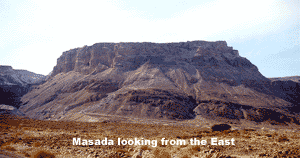
The Myth That Was Masada
by Jay Gary, Mar 30, 2002
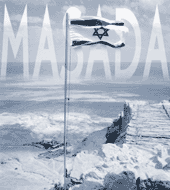
Masada is best known as the place where 960 Jewish fighters took refuge after the fall of Jerusalem, only to commit mass suicide in A.D. 74. When they realized the Roman Tenth Legion would finally break through their defenses, they chose to die by their own hands as “free people” rather than be enslaved.
Jews today claim the sands of time have not worn away the message of Masada. The tragedy has inspired both a mini-series and a rock opera. And, next to Jerusalem, Masada has become Israel’s most visited site and its most profitable tourism venue.
For years the young Israeli state used Masada as the site to swear in their soldiers. After finishing basic training, they would climb the crest of Masada at dawn and take a solemn oath, “We shall remain free men; Masada shall not fall again.”
For Holocaust survivors and Zionists the desert mountain is and forever will be, a sacred stronghold, a symbol of Jewish resistance against persecution.
Beneath the Stones

The enigma of Masada is that it was virtually ignored by Jews for nearly 1,800 years. After Flavius Josephus, the Jewish historian, recorded the tragedy for his Roman sponsors in The Jewish Wars, the Rabbis avoided it. It never appeared anywhere in the Jewish canon. To them it spoke of the failures of false messiahs. As religious minorities living on edge of larger cultures, Jews had little interest in apocalyptic prophets or revolutionary rabble-rousers.
But the winds began to blow the other way in the late 1800s. Propelled by end-time Christian beliefs coming out of Britain, Theodor Herzl founded the secular Zionist movement in 1897. His purpose was to create a sovereign Jewish state, preferably in their ancient homeland. Then in 1923, the Hebrew translation of “The Jewish Wars” by Josephus was published, turning the attention of European Jews back again to the ancient rock fortress.
In time Masada became a pilgrimage site to the Jewish underground operating under the British mandate. But it wasn’t until after 1948 and the establishment of the modern state of Israel that the stones of Masada were able to tell their own story.
From 1963 to 1965, a distinguished Israeli general and archaeologist, Professor Yigael Yadin, led an international expedition to plumb the secrets of Masada. Volunteers from dozens of countries paid their way to Israel to help professional archaeologists unearth the ruins.
Yadin’s explorations revealed the remains of the material glory of Herod the Great and the makeshift shelters of the Zealots. The work began with little more than stone ruins on the surface, the size of six-football fields. On the western side, the ancient Roman siege ramp was still visible, as well as ruins of various camps that General Flavius Silva had used in A.D. 73 to surround the Jewish last stand. Also visible were the ruins of a double defense wall Herod had once built around the mesa’s perimeter. Josephus claimed 70 guardrooms and 30 watch towers were built into this casemate wall.
In the northwest corner the excavation team discovered the Jewish rebels had built a synagogue into the defense wall after they seized Masada in A.D. 66. In the back room, Yadin’s team found fragments of Ezekiel, including chapter 37, which contains the dramatic vision of dry bones and Israel’s promised resurrection.
Yadin’s dig generated national euphoria in Israel, as he used a combination of showmanship and natural authority as a general to fit his findings into Josephus’s account. He would later share his discoveries in a 1966 book, Masada: Herod’s Fortress and the Zealot’s Last Stand.
A Royal Resort
According to Josephus, the Maccabees originally built Masada in 150 B.C.. But it was up to Herod the Great to recognize its strategic value. During his rise to power as a client king of Rome from 40 to 37 B.C., Herod kept his family at Masada while he laid siege to Jerusalem. When he returned to Masada, to his surprise he found his mother, fiancée, brother and 800 soldiers had been able to hold the entire time, despite being attacked by larger forces.
He immediately set about fortifying and furnishing the citadel as a royal refuge fearing “a peril from Jewish people” would arise again or even a “more serious [attack] from Cleopatra of Egypt.” Over a period of six years Herod transformed Masada’s mesa into a Dead Sea royal resort with an amazing array of palaces, Roman baths, steam rooms, storerooms, water cisterns and aqueducts.
Yadin confirmed that on the north side Herod had built a three-tiered hanging palace. At the hottest time of the day, this personal villa got more shade than any other part of Masada. From there Herod commanded a spectacular view of the Dead Sea, the Ein Gedi oasis and the Moab mountains.
Herod never had to use Masada again as a refuge. He reigned from 37 until his death in 4 B.C., but he must have visited often. When he did, it is unlikely that he ever dreamed, in the words of Josephus, “that he was to leave it to the Romans as their very last task in the war against the Jews.”
Visiting Masada
Following Yadin’s excavation, Israelis turned Masada into a national park. A cable car was built on the eastern side to take hundreds of people up to Masada each day. Today school children and foreign tourists mix as they walk through the restored ruins.
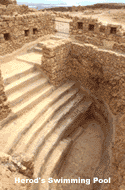
One can see the remains of Herod’s lavish steam room and elegant oval swimming pool, which drew its water from huge underground cisterns on the mountain. Also restored are two-plastered mikveh, or ritual baths, that the Jewish rebels built, to fulfil religious purity laws. Also visible are remains of the rebels’ personal belongings that were not burned--including garments, leather goods, baskets and house wares.
For most visitors, Masada is the place to hear tour guides retell of “the heroic life and struggle of the Jewish zealots.” While peering over the edge, they see how Flavius Silva ordered his troops to construct a huge ramp against the western slope, and imagine how the Romans launched heavy catapults and used an enormous battering ram to knock down the mountain’s protective wall. They hear how the Zealots hastily built a wooden wall to reinforce the double defense wall at the point of attack and how the wooden wall soon went up in flames.
A Twist of Fate
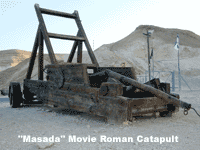
As the story goes, the Romans finally penetrated Masada in the Spring of A.D. 74 on the evening of the Jewish Passover, after a seven-week siege. The next morning they planned to ascend the mountain en mass and enslave the rebels. Unknown to them, the rebels had another plan.
According to Josephus, Eleazar Ben-Yair, the Jewish leader, gave a long speech that night in Herod’s Western Palace. He declared to his men that death by their own hands was more honorable than surrender or enslavement to the Romans. He proposed that a lottery be held, which would choose ten men to kill everyone. A second lottery would be held by the ten men to choose who would kill the remaining nine. The final man would die on his own sword.
On that following morning, as Josephus tells the story, the Romans “put on their armor, and laid bridges of planks upon their ladders from their banks, to make an assault upon the fortress.” Upon getting to the top they “saw nobody as an enemy, but a terrible solitude on every side, with a fire within the place as well as a perfect silence. So they were at a loss to guess at what had happened.”
Then “they made a shout…to try whether they could bring anyone out that was within; the [two] women heard this noise, and came out of their underground cavern, and informed the Romans what had been done, as it was done.” The Romans “did not believe it could be as they said; they also attempted to put the fire out, and quickly cutting themselves a way through it, they came within the palace, and so met with the multitude of the slain, but could take no pleasure in the fact, though it were done to their enemies. Nor could they do other than wonder at the courage of their resolution and the immovable contempt of death, which so great a number of them had shown, when they went through with such an action as that was.” (The War of the Jews, Book 7:402-406.)
Archaeology & Politics
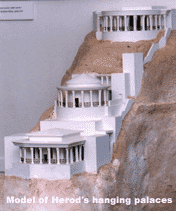
While Yadin made history at Masada, he also rewrote history to help a young nation find its place in the sun. Today considerable doubt has been cast on the initial findings of the Masada excavation.
Many inconsistencies, as built up by Yadin, are causing intellectuals in Israeli to think twice whether Masada should be applied to Israeli society. As an April 1, 2001 Jerusalem Post feature states, “For the better part of two generations, the Masada myth was a symbol of fledgling Zionist enterprise; it now threatens to slip back into obscurity.”
Back in the ‘60s, Yadin and his team found a collection of ostraca, or inscribed pottery fragments. Each had a single name on it, including one inscribed “Ben-Yair,” the family name of their leader, Eleazar. Yadin readily connected Josephus narrative of ten lots with these potsherds. But the lot consisted of eleven pieces, not ten as Josephus reported. Furthermore, over seven-hundred ostraca were found atop the mountain fortress, inscribed with single letters, women’s names, foodstuffs or priestly notations. It is more likely these fragments were merely part of the rebels’ rationing system for food. No single group of fragments can be taken as the lots cast on that fateful final night.
Another inconsistency revolves around the “remains of the last defenders.” Initially Yadin held out little hope of finding any of the skeletal remains of the final Jewish defenders, given that a Roman garrison was stationed on the Masada summit for some thirty years after its conquest. He reasoned the bodies would have been disposed of in one way or another for sanitary reasons. Yet during the excavations a south side cave below the cliff revealed the “stark sight of skulls and other parts of skeletons scattered in disorder about the floor.”
Yadin put the number of human remains at twenty-five and later claimed, “they can be only those of the defenders of Masada.” In 1969 the Israeli state arranged for a full military burial of these remains in Jerusalem.
Before his death in 1984, Yadin admitted he was pressured by the Israeli government to make that connection, even though the cave contained pig bones among the skeletons, a common sacrificial burial practice for Roman dead.
Masada is increasingly being understood as part of that “modern dance of politics and archaeology.” Archaeologists understand they are interpreters, rather than just restorers of a pristine past. As a 1993 Learning Channel show on Masada stated, “Every archaeologist is in a sense a myth-maker, contributing by his discoveries to the creation of a shared, national story of the past.”
Heroes or Traitors?
While many still cling to the “Masada Myth,” other Israeli scholars regard Masada “as a cautionary tale of bloody-mixed extremism, which should be maintained on the margins of Jewish consciousness—if at all,” claimed the Jerusalem Post.
Israeli sociologist Nachman Ben-Yehuda believes that Yadin’s portrayal of the rebels at Masada as “freedom fighters” and “patriots” was a far stretch. In 1995, he released a book entitled, The Masada Myth: Collective Memory and Mythmaking in Israel.
Ben-Yehuda claims the pre-state Israeli pioneers falsified and fashioned Josephus’s Masada story into “a powerful myth of heroism.” Whether by underground organizations, youth movements, the military, archaeological teams, mass media or tourism, Ben-Yehuda shows how the Masada narrative of Flavius Josephus was edited and augmented to become an ideological symbol of defiance for the modern state of Israel.
The Hebrew University professor also claims the portrait of Jewish heroism at Masada was never provided by Flavius Josephus. “On the contrary,” Ben-Yehuda writes, “The narrative conveys the story of a doomed (and questionable) revolt, of a majestic failure and destruction of the Second Temple and of Jerusalem ... of different factions of Jews fighting and killing each other, of collective suicide (an act not viewed favorably by the Jewish faith) by a group of terrorists and assassins whose “fighting spirit” may have been questionable.”
He further adds, “Josephus speaks of various Jewish groups who took part in the rebellion, among them the Zealots, but when it comes to Masada he mentions only one group—the Sicarii.”
Named after the Greek word for dagger—sica—the first-century Sicarii were religious fanatics notorious for assassinating moderate Jewish leaders and rabbis opposed to the revolt against Rome. In one instance, Josephus describes their killing 700 Jewish women and children in supply raids on Ein Gedi, a detail tellingly absent from the Masada visitor center.
Behind the Texts
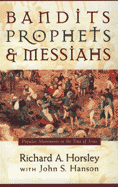
Like Ben-Yehuda, Richard Horsley claims the true defenders of Masada were thugs and assassins. A classics professor at the University of Boston, Horsley is the author of Bandits, Prophets & Messiahs: Popular movements in the time of Jesus (1985, 1999).
He claims “the Sicarii were highly discriminate and always directed their attacks against fellow [collaborating] Jews, not against Roman soldiers or officials.” In their campaign of urban terrorism, Horsley says the Sicarii employed three methods, symbolic assassinations, plundering the property of the wealthy and kidnapping leaders for ransom.
Horsley claims a proper reading of Josephus reveals that the Sicarii captured Masada in A.D. 66 and returned to Jerusalem with the weapons found there to incite the Jewish revolt again Rome. After overplaying their hand, other insurgents in Jerusalem quickly turned against them.
Horsley writes, “After being driven from Jerusalem in the summer of 66, they passively withdrew from the rest of the great rebellion and retreated to Masada...” He concludes, “The Sicarii simply sat out the rest of the long war against the Romans in their secure perch atop Masada.”
A Search for Answers
Scholars of the first-century remind us that Masada was part of a much larger Jewish revolt against the Roman Empire between the years 66-74. As Ben-Yehuda writes, “That revolt ended in disaster and in bitter defeat for the Jews. Masada was only the final defeat in the much larger suppression of that revolt.”
Is Masada a symbol of life or death? Does it reinforce our struggle against tyranny or warn us of our tendency to self-destruct?
According to popular Evangelical author, Tim King, answers to these questions “have been hard for both Judaism and Christianity to come by, but for different reasons.” “Judaism today,” King claims, “finds it necessary to think of itself as the ‘generation of the restoration,’ in contrast to the tragic ‘generation of destruction’ in the first-century.”
Since the rise of premillennial dispensation in the mid-1800s, King says Christianity has largely ignored what Jesus said about the impending self-destruction of his own generation, preferring instead to misapply that to our time.
As an author on forward thinking faith, King feels we should see Jesus’ entire ministry within the context of a century of Jewish resistance to Rome that ended with the fall of Jerusalem in A.D. 70.
He cites Jesus’ words in Luke 21:22, “for these are days of vengeance, to fulfill all that is written.” King says that in this very context, Jesus warned his followers to flee Jerusalem and not join the inevitable Jewish revolt, as it would lead to annihilation. And on biblical grounds King claims the destruction of Herod’s temple signified the vindication of Christ and his promised return in covenantal terms.
A growing number of Israelis are also taking a more nuanced view of the Great Revolt and Masada. Rather than automatically grant heroic status to the “last defenders” of Masada, they prefer to ponder how the Jews of the Second Temple period found themselves in such a precarious situation.
Among them is Shulamit Aloni, a former education minister. In the Jerusalem Post piece, he claims there was an alternative to Masada for the Jewish nation at that time. Aloni points to Rabbi Yochanan Ben-Zakai, who fled Jerusalem during the Roman siege and founded a Rabbinic academy south of Jaffa. “Instead of creating a shrine to the cult of casualties,” Aloni claims, “he built a house of prayer and study.”
The Masada Complex
Some Israelis see the parallel of their situation to misguided messianic revolts of yesterday and want nothing to do with anything resembling a self-destructive “Masada complex.” They consider reckless military force directed against Arabs as suicidal, that carried out to an extreme would provoke a Mideast version of the Alamo.
Others are not ready to embrace the changes that “post-Zionist” intellectualism might bring. Rather than accept internal critique that Zionism was a misguided project shaped by colonialism, they prefer to rehabilitate Zionism for the new century. Ammon Rubinstein is one such person, and seeks to chart the course forward in his book, One Hundred Years of Zionism. In doing so, he finds himself defending Zionism, not just from “post-Zionists” but also from “anti-Zionists” or from the likes of Sicarii-like Zionists who murdered Prime Minister Yitzhak Rabin.
Rubinstein claims that Rabin’s murder by a fellow Jew reveals a deep divide between two mutually alien perceptions: “humanistic, peace-loving and compromise-seeking Zionism on the one hand, and national-religious Messianism, which rejects the very principles of classic Zionist teaching, on the other.” While religious nationalists might appeal to Zionism, Rubinstein rejects their zealotry. Others do also, particularly in reference to the issue of territorialism.
According to educator Erez Eshel, “The Masada warriors of today are without a doubt those people living in Judea and Samaria. They have the spirit of Masada in them, and this is why they have not abandoned their settlements despite all the violence.”
Eshel is referring to some 200,000 Jews since 1967 that have occupied Palestinian land in the West Bank, and now stand as human obstacles to any just and lasting peace between Jews and Arabs.
Can anything be done to prevent another tragedy like Masada? Seasoned observers of the Middle East say that two challenges must be met head on before a just resolution can be reached: Arafat must curb terrorism on the part of Islamic suicide bombers and Israel must take immediate steps to dismantle the Jewish settlement movement.
Upon This Rock
“Is it wrong when worlds collide to want to live? Is it wrong?” asks a 1998 Masada rock opera. Of course the answer is “no.”
While Jews may need to rethink Masada as a national symbol, Christians no
less need to understand what Masada means, apart from the contemporary End-Time
scenario that claims a “King of the North” will soon invade Israel.
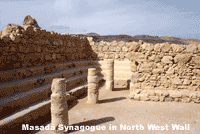
In this regard archaeology sheds some light. Yadin found that the Jewish rebels had an Ezekiel scroll, containing chapter 37—the vision of dry bones. This is where God once declared He would resurrect the nation of Israel and establish a new temple.
Tim King concludes, “The contrast could not be more vivid. Atop Masada you had Jewish defenders imagining a new world where powers like Herod and Rome are marginalized and priests rule in their place.” On the other hand, King claims the early Christians who fled the Great Revolt “saw Jesus’ resurrection as that new temple which became a restored house for Israel and all humanity by A.D. 70.”
Like the symbol of the rainbow after the flood, perhaps Masada still stands today, not to glorify a mass suicide, but to point to a fulfilled covenantal promise. If that is the case, as Christians understand it, then Masada can only point to that other Rock, upon which God restored a new world and brought a people back to life.
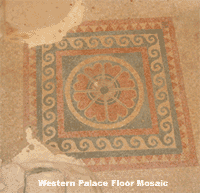
Brave and loyal followers! Long ago we resolved to serve neither the Romans nor anyone other than God Himself, who alone is the true and just Lord of mankind. The time has now come that bids us prove our determination by our deeds. At such a time we must not disgrace ourselves. Hitherto we have never submitted to slavery, even when it brought no danger with it. We must not choose slavery now, and with it penalties that will mean the end of everything if we fall alive into the hands of the Romans. For we were first to revolt, and shall be the last to break off the struggle. And I think it is God who has given us this privilege that we can die nobly and as free men... In our case it is evident that daybreak will end our resistance, but we are free to choose an honorable death with our loved ones. This our enemies cannot prevent, however earnestly they may pray to take us alive; nor can we defeat them in battle.
Let our wives die unabused, our children without knowledge of slavery. After that, let us do each other an ungrudging kindness, preserving our freedom as a glorious winding sheet. But first, let our possessions and the whole fortress go up in flames. It will be a bitter blow to the Romans, that I know, to find our persons beyond their reach and nothing left for them to loot. One thing only let us spare our store of food: it will bear witness when we are dead to the fact that we perished, not through want but because, as we resolved at the beginning, we chose death rather than slavery.
...After all, we were born to die, and those we brought into the world. This even the luckiest man must face. But courage, slavery and the sight of our wives led away to shame with our children—these are not evils to which man is subject by the laws of nature; men undergo them through their own cowardice if they have a chance to forestall them by death and will not take it... Come! While our hands are free and can hold a sword, let them do a noble service! Let us die un-enslaved by our enemies, and leave this world as free men in company with our wives and children.
Source: Excerpts from The War of the Jews, Book 7, by Flavius Josephus.